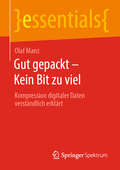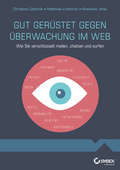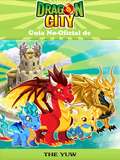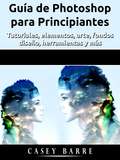- Table View
- List View
Guns, An American Conversation: How to Bridge Political Divides
by The Editors at Spaceship MediaBased on an article by Pulitzer Prize–winning reporters, the fascinating results of an important nationwide conversation about guns: Can complete strangers representing every point along the political divide engage in civil and productive discourse on the topic of gun control?As Americans, we spend a lot of time talking about guns. We have arguments, protests, declarations, and slogans about what kind of weapons can be sold and to whom. But the one thing we rarely have when it comes to firearms is a real conversation, and not just with members of our own tribe, but with people whose ideas don&’t align with ours. That is perhaps why the country is so divided when it comes to reducing gun violence. Guns, an American Conversation follows up on a handful of strangers—teachers and gun-rights advocates, hunters and police officers, mothers and fathers across the United States—brought together in a larger group of 150 people, for a month-long moderated Facebook group chat. The goal of the project—which expanded on earlier efforts—was to foster a civil, yet honest, dialogue between people whose backgrounds and beliefs led them to have opposing views on the issue. Not just a journalistic account, Guns attempts to map out common territory in a nation driven by profound divides. It includes sidebars, charts, and graphics that list additional information about gun control in the United States and provide the reader with tools to continue the discussion in their own lives. This book might not change your mind about gun control, but it will help you learn to cross divides in conversation.
Gut gepackt – Kein Bit zu viel: Kompression digitaler Daten verständlich erklärt (essentials)
by Olaf ManzBei der heutigen Datenflut, die auf Speichermedien und im Internet kursiert, ist die Kompression digitaler Daten nach wie vor ein immens wichtiger Aspekt bei Datenübertragung und -speicherung. Dieses essential erläutert ohne theoretischen Überbau und mit elementaren mathematischen und informatischen Methoden die wichtigsten Kompressionsverfahren, so unter anderem die Entropiecodierungen von Shannon-Fano und von Huffman, sowie die Wörterbuchcodierungen der Lempel-Ziv-Familie. Ausführlich eingegangen wird auch auf Irrelevanzreduktion und die Quantisierung bei optischen und akustischen Signalen, die die Unzulänglichkeiten des menschlichen Auges und Ohres zur Datenkompression ausnutzen. Illustriert wird das Ganze anhand gängiger Praxisanwendungen aus dem alltäglichen Umfeld. Die Aufbereitung erlaubt den Einsatz beispielsweise in Arbeitsgruppen an MINT-Schulen, bei Einführungskursen an Hochschulen und ist auch für interessierte Laien geeignet.
Gut gerüstet gegen Überwachung im Web: Wie Sie verschlüsselt mailen, chatten und surfen
by Johanna C. Czeschik Matthias Lindhorst Roswitha JehleSchnelle und einfache Schutzmaßnahmen gegen NSA , BN D, kriminelle Hacker und kommerzielle Datenkraken Sie möchten nicht, dass jemand Ihre E-Mails mitliest, Ihr Surfverhalten analysiert oder Ihre Kreditkartendaten ausspäht? Wie leicht es für Angreifer ist, Ihre Daten im Internet abzufangen, aber auch mit welchen einfachen Maßnahmen Sie sich dagegen schützen können, erfahren Sie in diesem Buch. Zum Einsatz kommt dabei überwiegend Open-Source-Software, die nicht nur kostenlos, sondern in der Regel sogar sicherer als kommerzielle Lösungen ist. Neben leicht nachvollziehbaren Schritt-für-Schritt-Anleitungen erhalten Sie viele praktische Tipps für bessere Passwörter und den Umgang mit sensiblen Daten. Die notwendigen technischen Grundlagen werden leicht verständlich und mithilfe vieler Abbildungen erklärt. Fangen Sie mit diesem Buch an, Ihre digitale Privatsphäre zurückzuerobern!Sie erfahren unter anderem,wie Sie Ihren Browser sicherer machen und anonym über das Tor-Netzwerk surfen.welche Vor- und Nachteile die verschiedenen Mailprogramme haben.wie Sie Ihre E-Mails mit PGP oder S/MIME ganz einfach verschlüsseln.welche Alternativen zu WhatsApp, Skype & Co. es gibt.
Gut-Busting Puns for Minecrafters: Endermen, Explosions, Withers, and More (Jokes for Minecrafters)
by Brian Boone Amanda BrackIt can’t get punnier than this!
Guía Del Idiota Total Para Vender En Ebay
by José Ramón Torres Nick VulichDescripción del libro:Guía del idiota total para vender en eBay es tu guía personal para hacer dinero en eBay. Su autor, Nick Vulich, ha realizado más de 29 000 transacciones en eBay en los últimos 13 años. Conoce los entresijos de las ventas en eBay y se ofrece para guiarte durante el proceso de venta.¿Te preocupa que no tengas nada que vender?No tienes por qué. Mira a tu alrededor. Todo el mundo tiene decenas de objetos en la casa y el garaje que puede empezar a vender hoy mismo. El hecho de que ya no uses tu viejo aparato de vídeo, sistema de juegos o portátil no significa que otra persona no lo quiera. A la gente le encanta las gangas. Ayúdalos a conseguir lo que quieren y échate algo de dinero al bolsillo en el proceso.Vamos a aprender cómo:Decidir qué venderAbrir una cuenta de vendedor en eBayAbrir una cuenta en PayPal (para que te paguen, RÁPIDO)Anunciar tu primer artículo en eBay con instrucciones paso a pasoOptimizar tus ventas con 28 consejos y trucosEnviar tus artículosInvestigar sobre artículos para obtener el mejor precio en cada ocasiónPrestar servicios al cliente, al estilo eBayNo dejes que el miedo te lo impida.Se calcula que más de 450 000 personas se ganan la vida vendiendo artículos en eBay.Millones de otras usan eBay para obtener dinero adicional y comprarse un coche, pagar la escuela de sus hijos o irse de vacaciones. ¿Por qué no tú?Otros millones quisieran vender en eBay, pero tienen miedo.Guía del idiota total para vender en eBay te conducirá paso a paso por el proceso de decidir qué vender, crear una cuenta en eBay y PayPal, y anunciar tu primera subasta.Todo esto se puede lograr en menos de una hora.No esperes otro minuto. ¡Pide tu copia de este libro hoy!
Guía Manual del Amazon Echo: Los 30 Principales Jaqueos y Secretos Para Principiantes del Master Amazon & Alexa
by The BlokeheadSu guía perfecta para el Amazon Echo! Este libro es un complemento y práctico compañero para principiantes que le permitirá a usted el ajusta y usar su dispositivo Amazon Echo rápida y eficientemente. Leyendo este libro usted entenderá y será capaz de recibir todos los beneficios que este maravilloso dispositivo tiene para ofrecer, permitiéndole a usted el mantener al día su apretada agenda. Usted aprenderá: Jaquear el control remoto. Controlar los dispositivos WEBO falsos. Controlar las luces y la temperatura. Conocer los mejores comandos. Y un montón más. Descárguelo AHORA y empiece a leer.
Guía No Oficial de Bubble Witch Saga 2
by Joshua Abbott Trans. Perla Allin Guzman VargasGuía de juego no oficial de Bubble Witch Saga, descripción, contenido, atajos, trucos y más!
Guía No Oficial de Dragon Mania Legends
by Joshua Abbott Carlos A. Valenti García*GUÍA NO OFICIAL* Consejos Avanzados & Guía de Estrategias.Esta es la guía más completa y detallada que encontrarás en lína. Disponible para descargar en tu dispositivo móvil, celular, lector de Ebooks, o en forma física. Con el éxito de mis cientos de guías escritas y estrategias he escrito otra avanzada guía profesional para jugadores nuevos y veteranos. ¡Contiene estrategias y consejos específicos para progresar en el juego y vencer a tus ponentes, adquirir más monedas, y muchas cosas más! - Consejos y Estrategias Profesionales. - Trucos. - ¡Secretos, Consejos, Trucos, Desbloquables, y Estrategias Usadas Por Profesionales! - Cómo Obtener Tonaladas de Monedas. - ¡Y MUCHO MÁS! Todas las versiones de esta guía incluyen capturas de pantalla para ayudarte a entender mejor el juego. No existe guía más completa y avanzada que esta. Disclaimer: Este producto no está asociado, afiliado, endosado, certificado, o patrocinado por el Acreedor Original de Derechos de Autor.
Guía No Oficial de Pet Rescue Saga
by Joshua Abbott Carme FolchGuía No Oficial de videojuego Pet Rescue Saga.
Guía No-Oficial de Dragon City
by Josh Abbott Hugo González Bruno¡Vence a tus oponentes! Con mi guía de juego aprenderás exactamente lo que hay que saber para convertirse en un jugador experto y vencer a tus oponentes. Esta es una guía completa con todo lo que necesitas saber sobre el juego, además de una copia gratuita del juego con esta compra. - ¡Como descargarlo de forma gratuita! - Compatible con iPhone, Android, y PC. - Información general e información básica - Consejos y estrategias profesionales. - Conseguir gemas. - Obtener comida. - Todo sobre torneos. - Todo sobre tipos de edificios. - Cómo hacer toneladas de oro. - Información de crianza de dragones. - Hábitats de dragones. - Instrucciones detalladas fáciles de seguir. - ¡Secretos, Consejos, Trucos, Desbloqueables, además de trucos usados por los jugadores profesionales! - ¡Y mucho más! ¡Comprala ahora y aplasta a tus oponentes! ¡Conviértete en un jugador profesional ahora! Por favor, ten en cuenta: Este producto no está asociado, afiliado, respaldado o patrocinado por Social Point, ni tampoco ha sido revisado, probado o certificado por ellos. Esta guía está para ser utilizada como una referencia y, como tal, no modifica el juego de ninguna manera. Esta es una guía completa y no un programa de Software.
Guía No-Oficial de Grand Theft Auto V
by Joshua Abbott Hugo González Bruno¡Haz toneladas de dinero! ¡Con mi guía no oficial de Grand Theft Auto 5 aprenderás exactamente lo que es necesario saber para convertirte en un experto! Mi guía cubre lo siguiente: - Estrategias para principiantes. - Consejos y estrategias para profesionales. - Iniciando. - Cómo ganar dinero infinito. - Armas. - Vehículos. - ¡Secretos, Consejos y Trucos utilizados por los jugadores profesionales! - ¡Y mucho más! ¡Cómpralo ahora y no vuelvas a tener bajo rendimiento! ¡Conviértete en un jugador experto ahora! Cláusula de renuncia: Este producto no está asociado, afiliado, aprobado o patrocinado por Rockstar Games. Esta guía es para ser utilizado como una referencia. El objetivo de esta guía es ser utilizada como referencia. Esta es una guía escrita y no un programa de software.
Guía Para El Autor Independiente: Cómo Crear, Publicar Y Promocionar Tu Libro Para Kindle
by Natalia Steckel Nick VulichIndie Author's Toolbox fue escrito tanto para autores nuevos como para autores experimentados. Es una guía para optimizar tu libro para Kindle, pero eso no es todo. Demasiados autores consideran a Kindle como la meta final de sus libros. Están tan inmersos en optimizar su libro para Amazon, lanzar KDP Free Days, Countdown Deals, y variar sus precios que se olvidan de una cosa: millones de personas nunca han comprado un libro para Kindle, ni ningún otro tipo de libro electrónico. Es cierto: Amazon es el chico grande de la cuadra. Se calcula que tienen el 65 % del mercado de libros electrónicos en Estados Unidos. Sin embargo, si sé hacer las cuentas, eso deja un 35 % de lectores estadounidenses que disfrutan sus libros electrónicos servidos de otra manera. ¿Puedes darte el lujo de ignorarlos? La iStore de Apple es el segundo mercado de libros electrónicos más grande del mundo. Kobo tiene una presencia fuerte en Canadá y en muchos otros países. Barnes and Noble aún conserva más del 15 % del mercado. Además, no nos olvidemos de que a muchos lectores todavía les gustan los libros a la antigua: en papel que puedan pasar con los dedos, con esquinas que puedan doblar y márgenes que puedan escribir. Hay millones de lectores que prefieren escuchar un libro en lugar de leerlo. Si no tienes tu libro en ACX, estás perdiendo millones de lectores potenciales que compran en Audible, Amazon y en la iStore. ¿No me crees? Considera lo siguiente: durante mi primer mes en ACX vendí más de 200 audiolibros, con cuatro títulos disponibles. En el próximo mes espero tener los 22 títulos en audiolibros y obtener alrededor de 1000 ventas por mes. Todo lo que me costó fue un simple Fiverr para crear la tapa de cada audiolibro. Para los adictos a Amazon, también voy a brindarles algo de información que puede ayudarlos.¡Oye! ¿Quieres saber un secreto? No hay secretos.
Guía Paso a Paso para Desbloquear Fire Stick Alexa TV
by Jonathan GatesGuía que explicará paso a paso como desbloquear su TV utilizando Fire Stick Alexa en sencillos pasos.
Guía de Escritores para Usar el Software de Reconocimiento de Voz
by Barbara WatkinsonComo escritores, todos sabemos lo que puede ser un increíble software de dictado de herramientas. Nos permite escribir más rápido y evitar los peligros de RSI y un estilo de vida sedentario. Pero muchos de nosotros dejamos de dictar cuando nos damos cuenta de que no podemos obtener la precisión que necesitamos para ser verdaderamente productivos. Este libro cambia todo eso. Con casi dos décadas de uso del software Dragon en su haber y una gran cantidad de conocimiento interno de la industria del dictado, en el libro se revelará cómo sobrecargar su escritura y lograr una precisión de reconocimiento inmejorable desde el momento en que comienza a usar el software.
Guía de Juego Geometry Dash Meltdown no Oficial
by Hiddenstuff Entertainment José Luis Patricio GonzálezAdemás de la compra de este libro electrónico, siéntete libre de registrarte en nuestro programa suplementario de guías gratuitas. Al copiar el link presentado a continuación ganarás acceso a las últimas actualizaciones y noticias de los juegos y aplicaciones online más populares. Regístrate de manera gratuita aquí: http://emailsignupform.subscribemenow.com/ Guía de Consejos Avanzados y Estrategias. La presente es la única y más detallada y completa guía que encontrarás online. Disponible para su descarga instantánea en tu teléfono celular, dispositivo eBook, o en formato físico. Con el éxito de mis cientos de otras guías escritas y estrategias, he escrito otra guía avanzada para tanto jugadores nuevos y veteranos. ¡Esta guía otorga estrategias específicas y consejos sobre cómo avanzar en el juego, vencer a tus oponentes, adquirir más monedas, y mucho más! Lo siguiente es lo que adquirirás con la compra de esta guía profesional avanzada y detallada de juego. - Estrategias y consejos profesionales. - Trucos y hacks. - ¡Secretos, consejos, trampas, desbloqueables, y trucos usados por jugadores profesionales! - Cómo conseguir muchas cantidades de dinero/monedas. - ¡Y MUCHO MÁS! Todas las versiones de esta guía poseen capturas de pantalla para ayudarte a entender de mejor manera el juego. No existe otra guía tan avanzada y completa como ésta. Si estás buscando guías sobre otros juegos y aplicaciones populares siéntete libre de buscar otros títulos por Joshua J Abbott o HSE Games. Estarás contento de haber comprado esta guía, y te beneficiarás de ella enormemente comparado a otras guías menos efectivos que circulan por la web. ¡Cómprala ahora y destruye a tus oponentes! ¡Conviértete en un jugador profesional hoy! Para soporte y mayor información sobre nuestros productos, visita: http://www.hiddenstuffentertainment.
Guía de Juego para Angry Birds Guerra de las Galaxias II
by Hiddenstuff Entertainment Tania CalderonCon mi última Guía de Juego de Angry Birds Star Wars II aprenderás exactamente lo que necesitas saber para convertirte en un jugador experto y obtener los puntajes más altos en cada nivel. Esta es una guía completa con todo lo que necesitas saber del juego Y ADEMÁS podrás bajar el juego gratis con esta compra. *Cómo bajar el juego Angry Birds Star Wars II GRATIS. *Secretos, tips, trampas y trucos usados por los jugadores profesionales. *Accesible para PC, IPhone y Android. *Una vista detallada de todos los pájaros. *Paso a paso de como vencer el nivel, obtener 3 estrellas y conseguir los puntajes más altos. *Vista de los logros. *Vista de todos los Mapas del Tesoro. *Vista de las Cajas de Bonus. *Vívidas capturas de pantalla. *Estrategias generales para el juego. *¡Y MUCHO MÁS! ¡Compra ahora y nunca más te quedes atorado tratando de pasar un nivel! ¡Conviértete en un Jugador de Altos Puntajes hoy! Aviso Legal Este producto no está asociado, afiliado, respaldado o patrocinado po Rovio Enterteinment Ltd. ni ha sido revisado, probado o certificado por Rovio Enterteinment Ltd. Esta guía debe ser usada como referencia y por tanto no modifica el programa en manera alguna. Esta es una guía escrita, no un programa de software.
Guía de Juego para Disney Crossy Road
by The Yuw Cecilia Esquivel B.*Guía No Official* Guía de tips avanzados y estrategías. Esta es la mas comprensica y más detallada guía que vas a encontrar en el internet. Disponible para descarga inmediata en teléfonos móviles, tabletas digitales para libros y tambien en fotmaro físico. Con el éxito de muchas otras guías de estrategías, que he escrito, ahora les traigo una guía profecional tanto para principiantes como para expertos en el juego. Proporcionando etrategías y tips específicos sobre como avanzar en el juego, conseguir más monedas, y mucho más. Todas las versiones de esta guía cuentan con gráficos e imagenes para facilitar su comprensión. Este producto no está asociado, afiliado o es patrocinado por los poseedores de la Copia Original de Derechos, no han sido revisados, probados o certificados por ninguno de los anteriores.
Guía de Photoshop para Principiantes: Tutoriales, elementos, arte, fondos, diseño, herramientas y más
by Hiddenstuff EntertainmentUna guía detallada para aprender a editar en Photoshop Esta guía lo ayudará a aprender acerca de las herramientas de Photoshop, su uso, el panel de capas de fondo y los colores. Basándose en una investigación detallada, este libro le enseñará cómo: - Realizar un conjunto de las mejores herramientas - Controlar el Panel de capas - Usar diferentes formatos para la impresión - Usarar pinceles, patrones y formas - Alterar los colores con capas de ajuste - Usar la barra de herramienta pluma - Usar atajos de teclado Si desea aprender los conceptos básicos de la edición de photoshop, entonces este libro es para usted. --> Desplácese a la parte superior de la página y haga clic en Añadir al carrito para comprar instantáneamente... Descargo de responsabilidad: Este autor y/o propietario(s) de los derechos no realiza ningún reclamo, promesa o garantía sobre la exactitud, integridad o adecuación del contenido de este libro, y expresamente renuncia a la responsabilidad por errores y omisiones en el contenido del mismo. Este producto es sólo para uso de referencia.
Guía de Usuario de Alexa 2019: A - Z Guía de referencia de Amazon Alexa para principiantes y usuarios avanzados
by Paul GartenAprende cómo usar Alexa con tu Smartphone y todos los dispositivos Amazon Echo. Edición 2019. Como el título sugiere, este libro está diseñado para ser una guía de referencia para todo lo que necesitas de los dispositivos Amazon Alexa y Echo smart. Descubre cómo configurar tus dispositivos Smart Home con Alexa. Domina tus Dispositivos Echo y Alexa en una hora. Mejora tu vida inteligente con esta guía. Desde Comunicación con Alexa, Skills, Entretenimiento, Productividad, Deporte, Compras por Voz, Noticias e Información, Configuración y Personalización dentro de la aplicación de Alexa, este libro lo cubre todo. Puedes tener una rápida vista previa del libro para ver su tabla de contenido.
Guía de Usuario de Amazon Echo: además de la completa guía de usuario y consejos
by Bob BabsonGuía de usuario de Amazon Echo: Dot, Show, Spot, Look, además de la completa guía de usuario y consejos por Bob Babson Una guía paso a paso sobre cómo sacar el máximo provecho de su dispositivo Amazon Echo Guía de usuario de Amazon Echo: Dot, Show, Spot, Look, además de la completa guía de usuario y consejos Una guía paso a paso sobre cómo sacar el máximo provecho de su dispositivo Amazon Echo * Admite todos los dispositivos Amazon Echo * La mejor característica del Echo es la inmensa funcionalidad que tiene. Aprenda a usar su dispositivo con todas sus capacidades, como lo hacen los profesionales Aquí está lo que obtendrás: -Compartir cuentas -Configuración -Alexa -Conectividad Bluetooth -Recordatorios -Rastreo de paquetes -Controlando otros dispositivos -Opciones -Actualización -Solución de problemas + ¡MUCHO MÁS! --> Desplácese a la parte superior de la página y haga clic en añadir al carrito para comprar instantáneamente... Descargo de responsabilidad: Este autor y/o propietario(s) de los derechos no hace ninguna reclamación, promesa o garantía sobre la exactitud, integridad o adecuación del contenido de este libro, y expresamente renuncia a la responsabilidad por errores y omisiones en el contenido del mismo. Este producto es sólo para uso de referencia.
Guía de Usuario no Oficial para Chromebook: La guía completa a las apps, instalación, herramientas, consejos, usar su dispositivo y más
by Bob Babson¿Usa su Chromebook regularmente? ¿Le gustaría aprender cómo usar su Chromebook como un profesional y ahorrárse montones de tiempo? Compatible con todas las versiones de Chromebook. Si su respuesta fue "sí" a cualquiera de estas preguntas, entonces esta guía es para usted. ¿Sabía que su Chromebook es capaz de miles de funciones, y que cada una de ellas hará su vida más fácil y le permitirá aprovechar mejor su tiempo? Sin embargo, debido a que hay tantas funcionalidades secretas, puede ser difícil saber exactamente cómo utilizar su dispositivo de forma óptima. Qué se incluye: -Cómo configurar. -Cómo navegar. -Capacidades del dispositivo -Cómo aprovechar mejor su tiempo -Cómo ahorrar esfuerzo y completar tareas con facilidad -Aprenda a utilizar su dispositivo como los profesionaless lo hacen. -Resolución de problemas + ¡MUCHO MÁS! Si quiere aprender a utilizar su dispositivo como los profesionales lo hacen, esta guía es para usted. --> Vaya al principio de la página y haga click en Añadir al Carrito Instantáneamente Advertencia: El autor y o el (los) propietario(s) de los derecho(s) no hacen ninguna declaración, promesa o garantía de la precisión, completitud o de la adecuación de los contenidos de este libro, y expresamente niegan responsabilidad alguna por errores y omisiones en los contenidos aquí expuestos. Este producto es para uso referencial únicamente. Por favor consulte a un profesional antes de actuar en base a cualquiera de los contenidos presentados a continuación.
Guía de desintoxicación digital: Cómo vencer la adicción a las redes sociales
by Gary RandolphAunque las redes sociales son una gran herramienta para comunicarse con los amigos y la familia, y para adquirir conocimientos e información, su uso sin límites no es bueno para la salud mental. Hoy en día las personas se han vuelto adictas a las redes sociales y también la actividad física que realizan ha disminuido. Si te has vuelto adicto a las redes sociales y quieres cambiar tus hábitos cotidianos, esta guía es para ti. Esta guía electrónica describe el proceso completo de Desintoxicación Digital. Si quieres vencer la adicción a las redes sociales, esta guía es para ti. En esta guía aprenderás: - Las diez mejores maneras de deshacerse de la adicción a las redes sociales - Cuentas que debes eliminar - Hacer un uso mínimo de las cuentas - Cómo limitar tu lista de amigos - Uso mínimo del dispositivo - Reorganizar tus prioridades - Tener tiempo libre para tus relaciones reales - Pasos a seguir - ¡Y mucho más! --> Desplácese hasta la parte superior de la página y seleccione "Añadir al carrito" para comprar inmediatamente Aviso de responsabilidad: Este autor y/o el/los propietario/s de los derechos de autor no aseguran, ni prometen, ni garantizan la exactitud, integridad o adecuación del contenido de este libro, y no se hacen responsables de los errores u omisiones en su contenido. Este producto es sólo para uso de referencia. Por favor, consulte a un profesional antes de aplicar cualquier medida sobre los temas incluidos en este libro.
Guía de juego Minecraft no Oficial
by Joshua Abbott José Luis Patricio González¡Con mi Guía Definitiva de Minecraft aprenderás exactamente lo que necesitas saber para convertirte en un jugador experto! La presente es una guía completa con todo lo que necesitas saber sobre el juego y ADEMÁS serás capaz de descargar una copia gratis del juego por la compra de esta guía. - Resume e información básica. - Estrategias avanzadas. - Todo sobre los objetos. - Todo sobre los Mobs. - Todo sobre los Biomas. - Todo sobre los encantamientos. - Todo sobre el crafteo. - Todo sobre los brebajes. - Todo sobre las mazmorras. - Todo sobre los mini juegos. - Todo sobre las granjas. - Cómo encontrar y derrotar al Ender Dragon. - Cómo conseguir objetos infinitos. - ¡Secretos, consejos, desbloqueables, y trucos usados por los jugadores profesionales! - Capturas de pantalla reales. - ¡Y MUCHO MÁS! ¡Cómprala ahora y nunca más tendrás que luchar por sobrevivir! ¡Conviértete en un jugador profesional!
Guía de juego no oficial de Angry Birds 2
by Hiddenstuff Entertainment Rafael J. Torres Gila¡Gana niveles, consigue Power-ups y obtén la mejor puntuación! ¡Con mi guía aprenderás todo lo que necesitas para convertirte en un jugador experto y superar todos los niveles! Esta es una guía completa con información imprescindible acerca del juego. - Consejos y estrategias nivel experto. - Trucos y hacks. - Recompensas diarias. - Tipos de pájaros. - Tipos de niveles. - Hechizos. - Gemas. - ¡Secretos, ayudas, trucos, desbloqueables y tácticas de jugadores profesionales! - Información relevante y estrategias de Wiki. - Estrategias generales de Apps para principiantes. - ¡Y MUCHO MÁS! ¡Consíguela ahora y acaba con tus enemigos! ¡Conviértete en un jugador profesional hoy mismo!
Guía de las GoPro Hero y Fusion: Cómo usar sus GoPro Fusion, Hero 4/5/6/7 Stock, White y Black
by Hiddenstuff Entertainment¡Aprenda a usar su dispositivo GoPro como profesional! Esta guía es para cualquiera que busque capturar videos sorprendentes con su dispositivo GoPro. Es válida para las GoPro Fusion, y Hero 4, 5, 6 y 7. Este libro incluye todo lo que necesita saber: -Hacer fotos y videos sorprendentes -Fotos de time lapse -Fotos giratorias -Compartir sus videos y fotos -Fotografía subacuática -Composición al filmar -Uso de la batería -Resolución y campo de visión -Técnicas de edición de video -¡Y MÁS!
























